Bumblefoot, a prevalent condition in avian species, refers to a painful and potentially debilitating infection of the feet. This ailment, also known as pododermatitis, affects various birds, including domestic and wild species.
Understanding bumblefoot is of utmost importance for bird owners, aviculturists, and conservationists, as it can significantly impact the health and welfare of these beautiful creatures.
This condition typically arises from bacterial infections that infiltrate minor cuts or abrasions on the foot, leading to inflammation, swelling, and abscess formation.
Left untreated, bumblefoot can cause lameness and compromise a bird’s ability to perch, walk, and forage, eventually jeopardizing its overall well-being.
Thus, a comprehensive understanding of bumblefoot’s symptoms, causes, diagnosis, and treatment is vital to ensure timely intervention and to implement preventive measures that safeguard avian populations from this potentially severe condition.
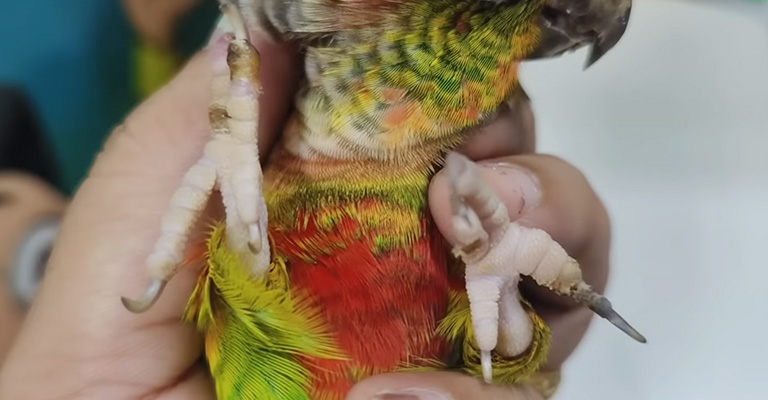
What Is Bumblefoot?
Bumblefoot, also known as pododermatitis, is a painful condition that affects birds’ feet. It is characterized by the presence of infections, typically caused by bacteria, in the foot tissue. Bumblefoot primarily occurs when minor cuts, abrasions, or punctures on the foot allow bacteria to invade the bird’s tissue.
Over time, this infection leads to inflammation, swelling, and the formation of abscesses. If left untreated, bumblefoot can cause lameness and significantly impact a bird’s mobility and quality of life.
Definition And Description:
Bumblefoot is where bacterial infections cause inflammation and abscess formation in birds’ feet. The term “bumblefoot” comes from the swollen appearance of the infected foot, resembling a bumblebee.
The infection primarily affects the soft tissue, including the skin, tendons, and bones, in the foot region. Common bacteria associated with bumblefoot in birds include Staphylococcus spp., Streptococcus spp., and Escherichia coli.
Types Of Birds Affected By Bumblefoot
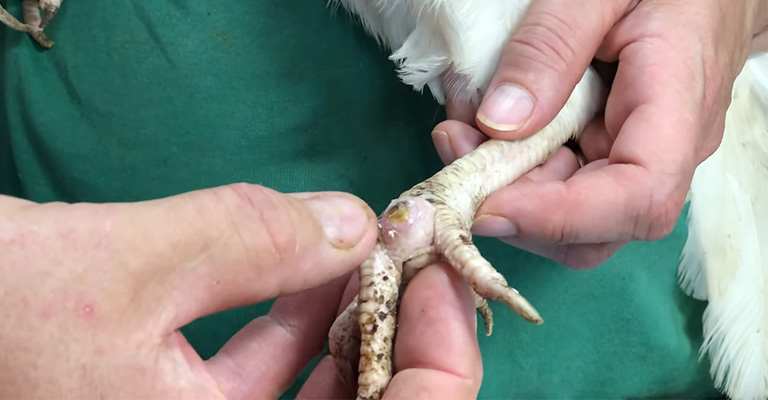
Bumblefoot is a condition that can affect various species of birds, causing inflammation and infection in their feet. Here are some types of birds commonly affected by bumblefoot:
Chickens
Bumblefoot is frequently seen in chickens, particularly those in captivity or confined spaces. The constant pressure on their feet from walking on hard surfaces can lead to small cuts or abrasions, making them susceptible to bacterial infections that cause bumblefoot.
Waterfowl
Ducks and geese are also prone to bumblefoot due to their frequently wet environments. Moisture can soften the skin on their feet, making them more susceptible to bacterial infections.
Additionally, the hard surfaces they walk on can cause foot injuries, increasing the risk of bumblefoot.
Birds of Prey
Raptors like hawks and eagles can develop bumblefoot, primarily if kept in captivity. These birds often perch on hard surfaces, and any injuries to their feet can lead to infections.
Bumblefoot can be particularly problematic for birds of prey as it affects their ability to hunt and fly effectively.
Parrots
Parrots, including species like macaws and cockatoos, can also suffer from bumblefoot. These birds often spend extended periods on perches that may not provide enough variation in surface texture, leading to pressure sores and foot injuries.
Improper perching materials and inadequate hygiene in their enclosures can contribute to the development of bumblefoot.
Pigeons
Pigeons are commonly affected by bumblefoot, especially those kept in urban environments where they frequently walk on hard surfaces, such as concrete or asphalt. Pigeons with bumblefoot may experience pain and difficulty perching, affecting their overall mobility.
Songbirds
While less common than in other bird species, bumblefoot can also occur in songbirds, including finches, canaries, and sparrows. These birds may develop the condition if kept in inappropriate cages with wire or mesh flooring, leading to foot injuries and subsequent infections.
It’s important to note that bumblefoot is a preventable condition in birds. Providing appropriate perches, maintaining clean and comfortable living environments, and monitoring their foot health can help minimize the risk of bumblefoot and promote the overall well-being of these avian species.
Bumblefoot In Birds- Symptoms
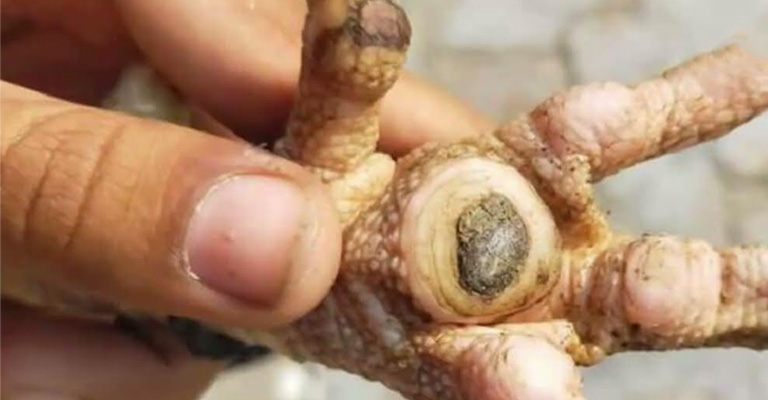
Bumblefoot, also known as pododermatitis, is a condition that affects the feet of birds. Here are some common symptoms of bumblefoot in birds:
Swelling
One of the primary signs of bumblefoot is swelling in the affected foot. The affected area may appear red, inflamed, or puffy. The swelling may sometimes be localized to a specific area or spread across the foot.
Lesions or Sores
Bumblefoot often causes lesions or sores on the bird’s foot. These lesions can range in severity from small scabs or calluses to more extensive, open wounds. The sores may be accompanied by discharge or the presence of pus.
Lameness or Difficulty Walking
Birds with bumblefoot may exhibit lameness or difficulty walking. They may limp, favour one foot over the other, or show signs of discomfort when putting weight on the affected foot. In severe cases, the bird may refuse to put any weight on the foot.
Changes in Behavior
Birds experiencing pain or discomfort from bumblefoot may display changes in behaviour. They may become less active, rest more, or show signs of irritability or aggression. The discomfort associated with bumblefoot can affect their overall demeanour and quality of life.
Loss of Appetite
In some cases, birds with bumblefoot may experience a loss of appetite. The pain and discomfort associated with the condition can affect their ability to perch, move, and access food.
A decrease in food intake may result in weight loss or a general decline in health.
Abnormal Foot Appearance
Bumblefoot can cause visible changes in the affected foot. The foot may appear swollen, discolored, or have a rough, scaly texture. The presence of sores, scabs, or open wounds may be evident.
It’s important to note that bumblefoot can affect one or more feet, depending on the severity and progression of the condition.
If you notice any of these symptoms in your pet bird, it’s crucial to seek veterinary care promptly. Bumblefoot can worsen if left untreated and may lead to more severe complications, such as bone infection/
Bumblefoot In Birds- Causes
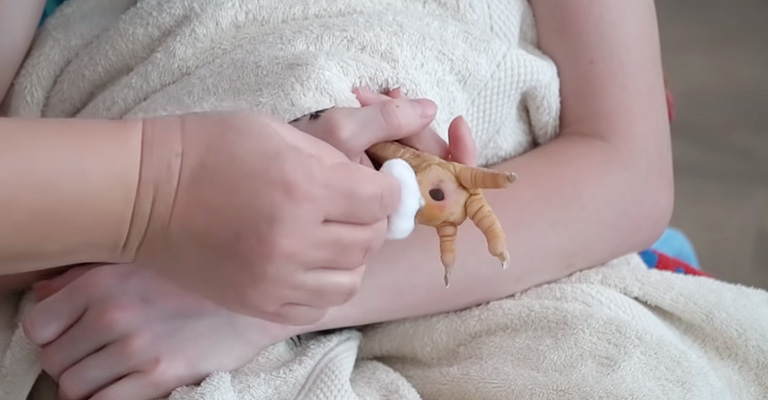
Bumblefoot, also known as pododermatitis, can be caused by various factors in birds. Here are some common causes of bumblefoot in birds:
Pressure Sores
Birds that spend extended periods perching on hard or rough surfaces may develop pressure sores on their feet. Constant pressure and friction on the foot pads can lead to skin breakdown, making it more susceptible to infection.
Poor Perching Surfaces
Inappropriate or inadequate perching surfaces can contribute to the development of bumblefoot. Perches that are too narrow, rough, or made of materials that don’t provide enough variation in texture can cause foot injuries and increase the risk of infection.
Nutritional Imbalances
Improper diet and nutritional imbalances can weaken birds’ immune systems and compromise their foot health. Birds require a balanced diet with sufficient vitamins and minerals to maintain healthy skin and tissues. A lack of essential nutrients can make birds more prone to developing bumblefoot.
Obesity
Obesity in birds can put extra strain on their feet and increase the likelihood of developing bumblefoot. Excess weight can exacerbate the pressure on the foot pads, leading to tissue damage and increased susceptibility to infection.
Trauma or Foot Injuries
Any form of trauma or injury to a bird’s foot, such as cuts, abrasions, or puncture wounds, can introduce bacteria into the foot pad, leading to bumblefoot. Birds may injure their feet while landing, perching, or interacting with rough surfaces or objects.
It’s essential to address the underlying causes of bumblefoot to prevent its occurrence and recurrence. Providing appropriate perching surfaces, maintaining clean living environments, ensuring a balanced diet, and promoting regular exercise can help reduce the risk of bumblefoot in birds.
Bumblefoot In Birds- Diagnosis
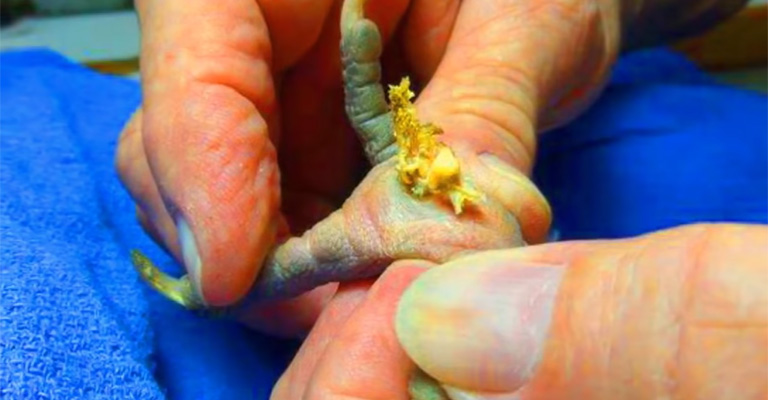
Diagnosing bumblefoot in birds typically involves a combination of visual examination, physical assessment, and, in some cases, diagnostic testing. Here are some standard methods used for diagnosing bumblefoot in birds:
Visual Examination
A veterinarian will inspect the affected bird’s feet for signs of bumblefoot. They will look for swelling, redness, lesions, sores, or any abnormal foot appearance changes. The presence of these visual symptoms can help confirm a diagnosis of bumblefoot.
Physical Assessment
The veterinarian will conduct a physical assessment of the bird’s feet, checking for pain, tenderness, or discomfort. They may gently palpate the foot pads and joints to evaluate the extent of inflammation or infection. The bird’s gait and mobility will also be observed to assess any lameness or difficulty in walking.
Radiographs (X-rays)
In some cases, X-rays may be used to evaluate the severity of bumblefoot. X-rays can help determine if there are any underlying bone infections or fractures associated with the condition. This diagnostic tool provides a detailed view of the affected foot’s internal structures, aiding in the assessment and treatment planning.
Bacterial Culture
If open sores or discharge are present, the veterinarian may collect samples for bacterial culture. This involves swabbing the affected area to identify the bacteria causing the infection. The results can help guide the choice of appropriate antibiotics for treatment.
Blood Tests
Blood tests may assess the bird’s overall health and immune function. Abnormalities in blood cell counts or specific markers can indicate underlying health issues that may contribute to the development of bumblefoot or affect the bird’s ability to heal.
The specific diagnostic approach will depend on the severity of the bumblefoot and the bird’s overall health condition. Once a diagnosis is made, appropriate treatment options can be discussed and implemented to address the underlying infection and promote healing.
Bumblefoot In Birds- Treatment
Treating bumblefoot in birds typically involves a combination of medical interventions and supportive care. Here are some standard methods used for treating bumblefoot in birds:
Antibiotics:
Bumblefoot is often associated with bacterial infections, so antibiotics are commonly prescribed to combat the disease. The choice of antibiotics will depend on the specific bacteria involved, as determined by a bacterial culture or the veterinarian’s clinical judgment.
Wound Care
Proper wound care is crucial for managing bumblefoot. This may include cleaning the affected area with a mild antiseptic solution or saline, removing dead tissue or scabs, and applying topical treatments or dressings to promote healing. The veterinarian may guide appropriate wound care techniques.
Pain Management
Birds with bumblefoot may experience discomfort or pain so pain management strategies may be employed. This can involve using analgesics or non-steroidal anti-inflammatory drugs (NSAIDs) to alleviate pain and reduce inflammation.
Foot Support and Bandaging
In some cases, supportive measures such as foot support or bandaging may relieve pressure on the affected foot and promote healing. Splints, padded wraps, or specially designed boots may provide support and protection to the foot.
Environmental Modifications
Modifying the bird’s living environment is crucial to prevent further damage and recurrence of bumblefoot. This may include providing appropriate perching surfaces that are wide, smooth, and comfortable, as well as ensuring clean and dry living conditions to minimize the risk of reinfection.
Nutritional Support
Proper nutrition is essential for overall bird health and healing. Ensuring a well-balanced diet rich in essential nutrients, vitamins, and minerals can support the bird’s immune system and aid in recovery.
Surgical Intervention
In severe or chronic cases of bumblefoot, surgical intervention may be necessary. This can involve the removal of infected tissue, abscesses, or foreign bodies, as well as addressing any underlying bone infections or deformities.
It’s important to note that the treatment approach may vary depending on the severity of the condition, the species of bird, and individual factors.
Working closely with a veterinarian experienced in avian medicine is crucial for developing an appropriate treatment plan tailored to the specific needs of the affected bird.
Frequently Asked Questions
Bumblefoot can be prevented by providing suitable perches with soft padding, maintaining proper hygiene in the bird’s living environment, and ensuring a balanced diet.
Bumblefoot is not contagious, but the bacteria responsible for the infection can spread to other birds if they come into contact with contaminated surfaces or materials.
While minor cases of bumblefoot may be treated at home under veterinary guidance, it is generally recommended to seek professional care to ensure appropriate treatment and prevent complications.
In severe cases where the infection has spread extensively or if the bone is affected, amputation may be necessary. However, with prompt and proper treatment, most issues of bumblefoot can be resolved without resorting to amputation.
Birds that spend significant time on hard surfaces or perches, such as chickens, ducks, geese, and captive parrots, are particularly susceptible to developing bumblefoot.
Conclusion
Bumblefoot is a common condition in birds that can cause discomfort, lameness, and potential complications if left untreated.
Bird owners must be vigilant and provide appropriate preventive measures such as cushioned perches, a clean living environment, and a well-balanced diet.
In case of bumblefoot occurs, prompt veterinary care, including proper diagnosis, treatment, and wound management, can help alleviate the condition and promote the bird’s recovery.